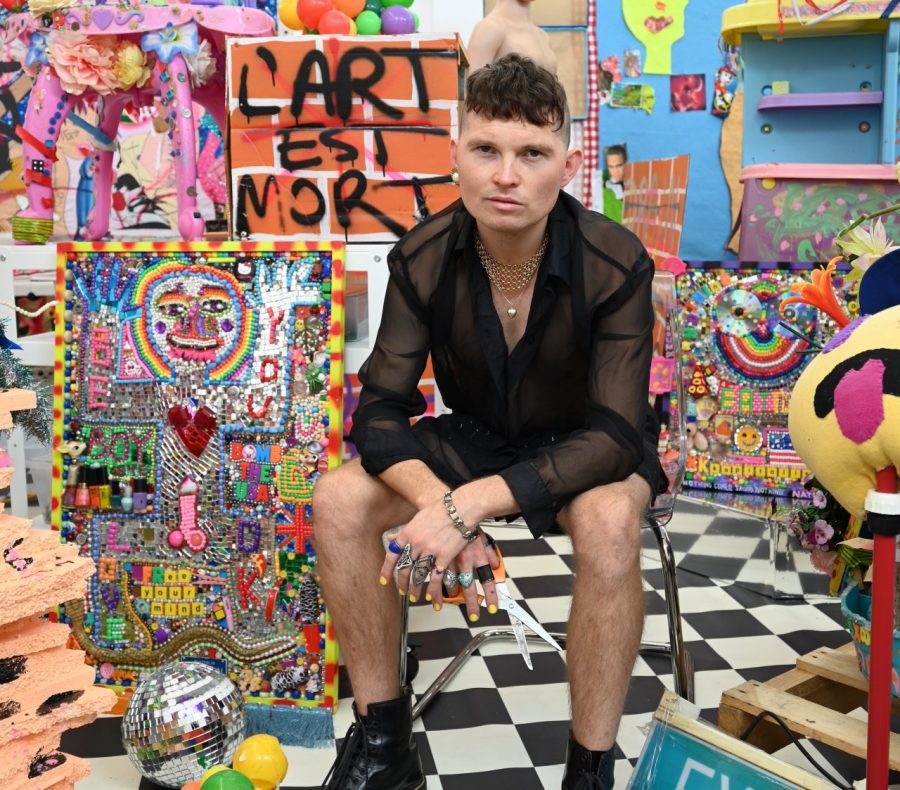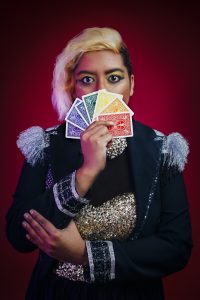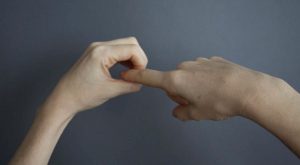Archer Asks: Artist Paul Yore on trash, psychedelia and sobriety
By: Alex Creece
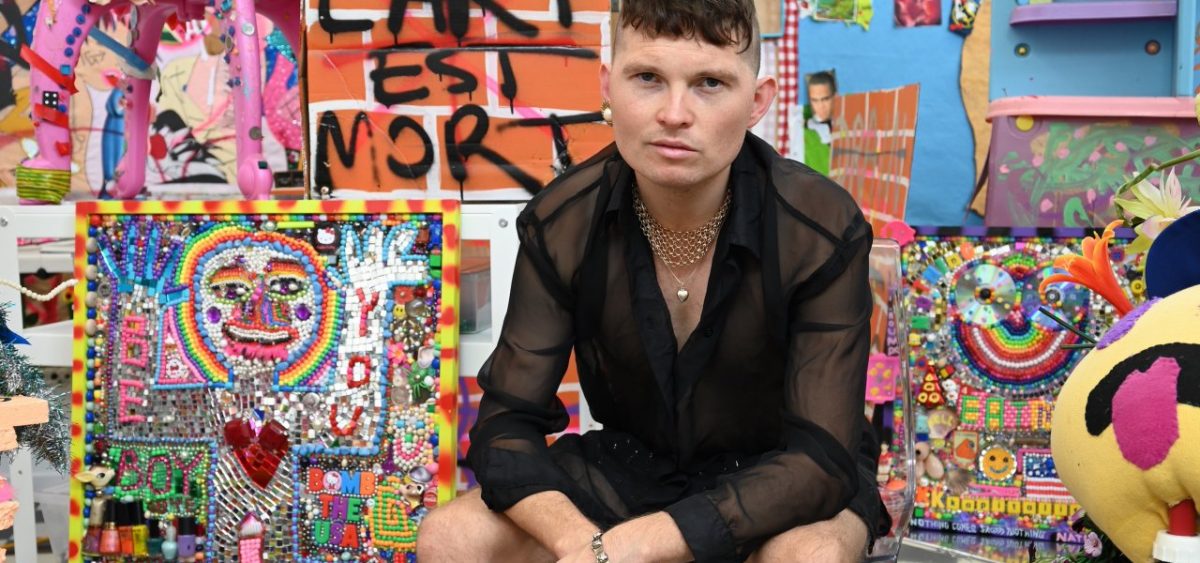
Paul Yore was born in 1987 in Naarm, and lives and works on stolen, unceded Gunaikurnai land. Yore completed studies in painting and anthropology at Monash University in 2010, before taking up full time work as an artist. He is celebrated as a prominent queer artist working across installation, sound, video, collage, and textiles.
Paul Yore has shown in major institutions across Australia, and extensively internationally, including in Austria, Belgium, France, Germany, Mexico, the Netherlands, Poland, South Korea, the UK and USA. His work is held in various public and private collections, both in Australia and internationally.
Alex Creece spoke to Paul Yore about art, trash, sobriety, capitalism and censorship after completing a mentorship with him through Midsumma Pathways.
Header image by: Devon Ackermann
Alex Creece: Hey Paul, thanks for chatting with me today! To start us off, can you tell us about your creative process? How does inspiration strike you? And how do your ideas escalate into these amazing and intricate artefacts? There’s a multi-pronged question for you!
Paul Yore: Like a lot of artists, I think the line between experimentation and inspiration is a really blurred one for me. My artistic process is centred a lot around collecting found materials, images and forms.
Through the process of collecting the raw material, the inspiration comes through processing, analysing and interrogating those materials, and then the work is generated from the themes that I find embedded in them. I often build on things in this way, but I am quite traditional too in that I always go back to drawing a lot, and also in looking at art history and the work that other artists have done.
I take inspiration from sort of compositions or forms or methodologies, I guess. There’s always this push-and-pull between not feeling like you have to reinvent the wheel with some of those very foundational principles about how you make something, but then also trying to push materials and turn them on their head as well.
AC: Good answer! As a collage artist myself, I’m a big fan of thrifting and repurposing found objects. Can you talk about how you accumulate your materials?
PY: It’s funny, I often get asked, “Where does this stuff come from?”, but just look around you! I’m always amazed by how much trash is just around us.
I live regionally now, and have quite a while, and there’s trash here – there’s trash everywhere – but when I go into the city, I’m actually amazed by the piles of trash you find. I used to collect a lot of stuff from the side of the road in hard rubbish, for example. Or things out of the gutter.
I also do a lot of op-shopping, and where I live, I find a lot of haberdashery materials, wool blankets, sequins and other kinds of remnants of quilting and embroidery practices that are strongly maintained in regional areas in particular.
As a tangent, I think conceptually, the status of trash, and the way it inhabits the alley or the gutter or the margins of society, has always been a site of interest for me. I always draw a parallel to queer identity, and the fact that, as queer people, we sort of inhabit the status of marginality. That’s always been a precarious kind of thing. For queer people, especially queer and trans youth, there’s a lot of vulnerability and this kind of marginality is very difficult thing to be negotiated.
On the other hand, I’m always tentative to give up the status of marginality for queer people as I think it’s also something we need to fight to preserve: this sense that we’re not seamlessly embedded in cis-heteronormative culture.
That’s a side note, but I guess that in terms of my collecting materials and trash, I am interested in those things that are thrown out and cast out of society. I think it relates back to a question of what’s valued and what ‘belongs’ in domestic space, versus what’s violently rejected from it.
Sorry, that was a bit of a rambling answer to what you asked!
AC: No, I loved it! Those parallels between trash and queer identity really resonated with me, as something of a queer trash gremlin. I’m very much a hard rubbish scavenger as well, and also being regionally based, I notice the different trends and patterns when visiting a local op shop versus visiting Savers on Sydney Road (Brunswick, Melbourne), for instance.
Following on from that, could you talk a bit more about how your queerness informs your art and your arts practice?
PY: This is a prickly kind of question because, on one hand, I don’t see my interrogation of materials and the work I make as only about queerness, or particularly the idea of queerness as it connects to my own identity.
I see my work as an examination of a broader cultural landscape and climate, you know, which is an examination of Australia’s colonial history, an examination of the ways in which like Australia has imported a lot of American forms of globalised neoliberal capitalism, and how much that dictates the behaviour and mentality of Australian society in its ideological tone. So, for me, I often talk about queerness as a kind of methodological approach rather than an ontological status.
I don’t necessarily see ‘queer’ as a synonym of ‘LGBTQIA+’ or ‘gay’, I see it more as an open-ended kind of category or attitude that should defy or resist categorisation or easy definition. I think that’s where queerness is most potent and radical: in this idea of disrupting, dissenting and destabilising. I think of queerness in ways that involve hybridity, or performing different ideas of what identity and gender can even be.

BOYS GONE WILD, 2012 wool and synthetic fibre on canvas (78.0 x 200.0 cm). Courtesy of the artist, Hugo Michell Gallery Adelaide and STATION Gallery Melbourne and Sydney. Photo credit: Devon Ackermann.
AC: My next question is a little bit similar, but rather than being about queerness, do you have any reflections about being a regionally based artist?
PY: I grew up in the city, and I see so much of my approach to things as being heavily informed by that, and by going out clubbing in my late teens and early twenties. But my mum grew up on a dairy farm in Gippsland, the same region where I now live. Childhood trips out to the dairy farm did inform my love of birds, nature, trees and the landscape.
I see culture increasingly intensifying in its tone, both in the online space and physical environment of the city. I find it can be quite toxic and difficult to navigate. Because my work is very slow and laborious, I see it as a form of therapy and catharsis. I think I do need a sense of disconnection from the busy-ness and deluge that you get in the city.
Getting out of the city has been really necessary for me, and it fulfills a lifelong dream to create a different rhythm and pattern in my life and my work. It’s been much more conducive to my work, but that’s also coupled with things like being sober and thinking about my experience of reality in a different way that’s not dictated by those assumed norms – those expectations of how you should act, behave and consume, and ideas around productivity.
AC: If you feel comfortable talking about it, I was wondering whether you felt any difference in your art since becoming sober? I feel like it’s such a typical thing in the art world to have your art informed by substances, either while you’re making the artwork or as a form of inspiration.
Many artists document the effects of different substances on their work – painting while on shrooms, and acid, and so forth – but there’s not much discussion around the relationship between art and sobriety.
PY: It’s a good question, and thank you for asking it because this is something that I’m really fascinated by. It doesn’t get talked about enough, really: both sobriety and the strong connection between creativity and drug use. Alcohol is one thing, but I certainly did dabble in my teens and early twenties with lots of different drugs. I’ve talked quite openly about that in the past; I think it did inspire particular trajectories in my work and my thinking.
When I was at art school, I did research about the history of psychedelic culture, going back to the 1960s counterculture, and figures like Aldous Huxley, Timothy Leary and Terence McKenna. Psychedelia maintains this subcultural status – it’s still quite a taboo – and yet the links between therapy and creativity that emerge in that space are really interesting.
I think for me, because of my experiences with mental health issues, I decided that I didn’t want to engage in drug use, alcohol, smoking – all those things I did when I was younger. I’ve been sober for over a decade now, completely sober. It was necessary for me to do that because of the time-consuming nature of my work, and the serious and studious approach that I have to making art.
I’m very old-school in the sense that I treat my art like a job. When I’m in the studio, it’s quite a rigorous kind of process. For me, the party lifestyle just conflicted too much with that kind of approach. However, I’ll always say that my experiences with drugs, alcohol and the gay club scene really strongly informed both the visual tone of my artwork and this idea of being immersed in colour, form and sound. That sense of queer belonging, or otherworldliness, or even queer rituals, are all connected to my work.
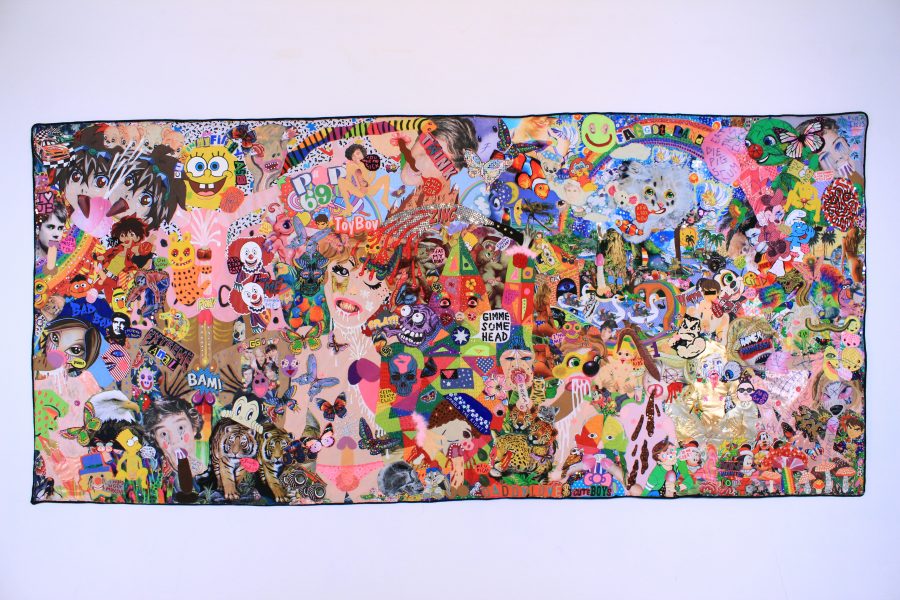
HEADS ARE SPINNING, 2015 mixed media textile appliqué comprising found materials, reclaimed fabrics, wool, beads, sequins, buttons, marker, acrylic paint (188.0 x 399.0 cm). Courtesy of the artist, Hugo Michell Gallery Adelaide and STATION Gallery Melbourne and Sydney. Photo credit: Devon Ackermann.
AC: That makes a lot of sense! Your work is very maximalist in a way that’s often associated with psychedelics. I can definitely see that influence, but I also think sobriety isn’t spoken about enough in the queer community, and there are lots of assumed norms about substance use. There’s something really interesting about your art being psychedelic in appearance, but your construction being a sober practice both literally and figuratively.
For my next question: what do you love about the art world, and what would you change about it?
PY: I have a real love-hate relationship with the art world. In my career, I’ve seen myself so much as an outlier in the art world because of experiences with my work being scandalised and censored and things like that. But then, I’ve also been really lucky with the platforms I’ve achieved in spaces that I didn’t ever think that I’d be able to find visibility.
To be frank, the thing I love about the art world is other artists. Meeting and talking to other artists is where I find the most joy and kinship. There’s always a difficult relationship that artists have with the commercial art world, with art institutions and with academia. There are always power dynamics that have to be negotiated – these can lead to great collaborative partnerships, but can also become examples of exploitation.
The thing I hate about the art world is the centralisation and bureaucracy. This happens in a lot of spaces, and the art world is no different. There’s a very corporate approach in a lot of settings that has depleted the sense of spontaneity and creativity that we all love about art.
In terms of what needs to change in the art world, it’s representation. The industry is still very top-heavy. As a cisgender white man, I can definitely say we need more representation. Even art schools now are talking about their admission policies and how they’re still tethered to things like grades, and potentially favour certain demographics, and not necessarily attracting the most diverse constituents that it possibly can.
Another thing I would say is like the art world is not a singular homogeneous thing, either. Like, there’s a mainstream institutional art world, and then there’s art that’s happening everywhere. There are like kids who go out and, you know, spray paint things on walls. And that’s also like a valid kind of expression of creativity. Art is happening in lots of different places out in the world, whether it’s acknowledged by mainstream society is a different question.
AC: I want to ask you about this tension between art and capitalism. Like, you’re creating art, but you live in a capitalist society, so you need to make money. For me, it can feel a bit funky trying to assign monetary value to my art. Obviously, we’re not in the same situation – you’re a full-time artist – so how do you deal with the inherent worth of your art, versus the fact that you need to live off it?
PY: Hmm, it’s a really good question. It’s a big, prickly question. I think you identified it in the question: there’s a lot of tension there, as artists are also workers.
In other countries say, like in France, there’s a living wage for artists. There’s a high bar to meet, but once you meet it, the government will actually give you a living wage as a baseline for being a working artist. That means that you don’t necessarily have to juggle three jobs to sustain your practice because art is valued as a valid form of work, and it’s seen as contributing to society.
We know that artists contribute huge amounts of income to the economy, and support tourism and all kinds of industries that no one ever talks about. But more than that, access to the arts has a huge effect on people’s mental health, their sense of wellbeing in society and their sense of self and culture. Art is part of what makes us who we are.
Those things are still undervalued. I think artists are very good at internalising a sort of kind of gratitude economy of, like, begging and competing. And this filters down into artists being mistreated economically, where we think that our work is something we should do on the side, or not make money from.
I’ve been very lucky in the sense that I have been able to work full time as an artist. I’ve juggled the kind of demands of showing at public institutions and also in commercial context, and often times these things can be seen in conflict.
And you know, as an added layer, as you identified too, I do see my work as interrogation of capitalism and neoliberalism. Then there’s this real prickly, kind of paradoxical thing about the work then becoming a commodity in an art gallery. That’s something I don’t have an easy answer for.
As I get older, I think I’m less naive or optimistic about the idea that art can sit outside of the culture critiquing it. Artists are inherently embedded in those totalising structures like capitalism, which is to say, I think the complicated ways in which those dynamics operate is something that artists can take up in their work. I don’t see my work as an artist as identical to the work of activism.
I think activism is something that happens outside of the art world in many respects. I see art as having a different but still valuable role, which is more speculative and philosophical, maybe. It’s discursive in that it allows a shift in people’s attitudes and ways of looking at the world, which has a slower flow-on effect in terms of a political change.
For me, I’ve actually benefited a lot from showing in commercial context because it can be less bureaucratic. My work’s never been censored in a commercial gallery, for example, or I can’t say the same for galleries that are funded by the council or the government, where there’s a lot of bureaucratic oversight and there’s a lot of expectation that money spent on art should be justified in a certain way.
So ironically for me, commercial venues have been the space of most freedom to actually, like, show more radical, explicitly queer kind of works. But yeah, it’s not an easy answer to those questions. I think they’re ongoing negotiations.
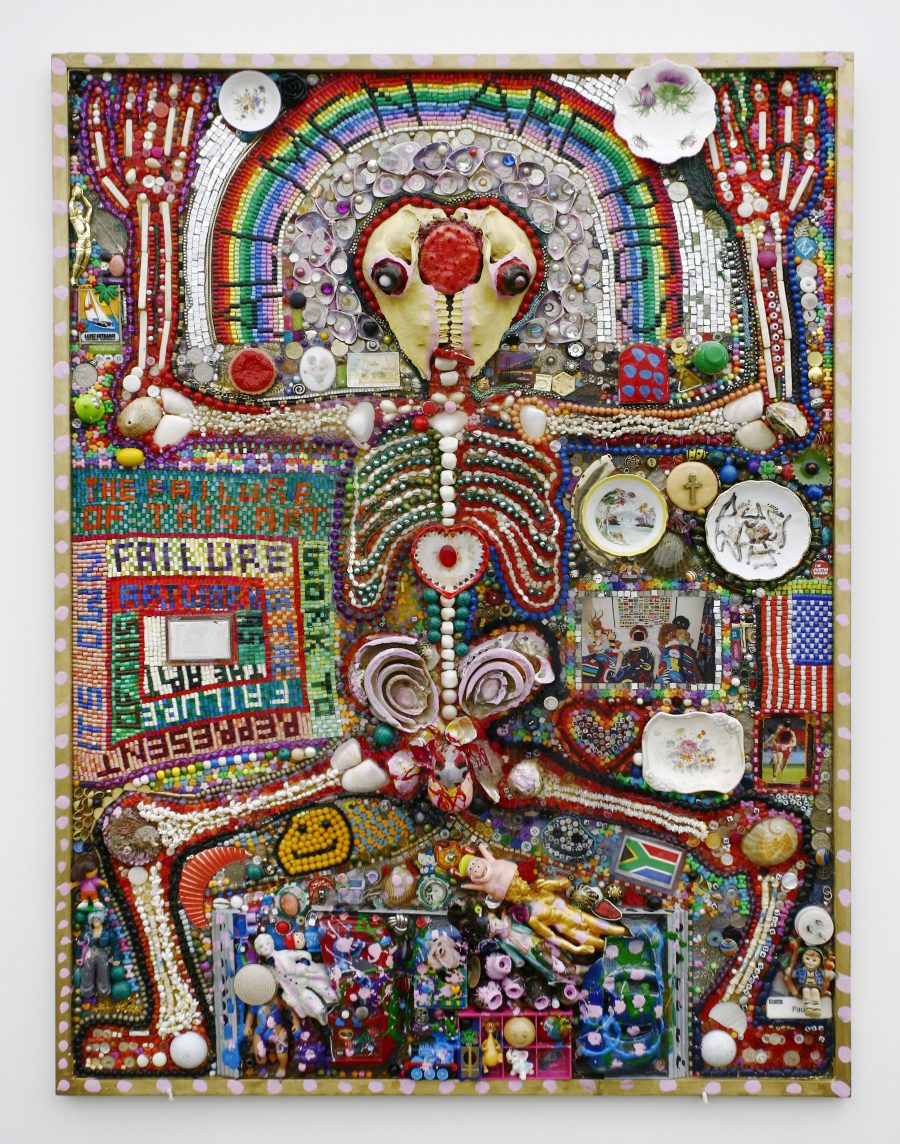
ALL MEN ARE PIGS, 2018 mixed media assemblage comprising found media assemblage comprising found objects, beads, buttons, enamel, shells, jewellery, nail polish, collage, ceramics, marker, acrylic, resin on wood (120.0 x 90.0 x 14.0 cm). Courtesy of the artist, Hugo Michell Gallery Adelaide and STATION Gallery Melbourne and Sydney. Photo credit: Chris Crocker.
AC: Yeah, absolutely. And that leads in nicely to my next question about – dare I say – censorship. You’ve already touched on it a couple of times, but yeah, if you feel comfortable, do you want to talk a bit more about your experiences of censorship?
PY: Alright, you’ve brought up the C-word! I mean, I guess if it was going to happen to me, I was lucky that it happened to me very young and early in my career.
I think I’ve built a lot of resilience and complexity in my work as a result of having these very violent and extreme reactions from people that I honestly never intended or predicted with showing my work in different contexts. Now, as I mentioned in my previous answer, I think a lot of that resulted from different entanglements with things that are completely outside of the art itself, you know, like people complaining about the way in which council money was being spent, for example, or complaints from people who hadn’t even seen the work.
But in terms of the artwork itself, there’s the extreme sort of censorship when a work is actually taken out of an art gallery, which is uncommon. But I think there’s a much more common and invisible form of censorship that happens in the boardroom or at a curatorial level, where the censorship is more about deciding not to show some something in the first place or inviting an artist at all. I think that’s the trickier and more troublesome dynamic for me.
We live in a risk-averse society, particularly in Australia, because there’s a hesitancy in the upper echelons of the art world to go into bat for art that they know might be problematic or challenging for certain viewers. And then the flow-on result is the impoverishment of our cultural environment.
Often the framing of these questions is from the perspective of this assumed viewer who represents a white family or something like that. There’s an invisible hypothetical when the institution says, “Oh, this work might not be suitable for some viewers.”
I don’t think it’s ever considered that the viewer is queer or interested in sexuality, so I think even the standpoint of the institution can be really problematic.
As I said, my censorship experiences have made me more resilient as an artist, and made me think about questions that are probably really important for all artists to think about anyway: What does it mean to put something in an art gallery? What deserves to be represented? What can be represented in the age where millions and millions of photographs are floating around in digital space? What does it even mean to be producing new images as a visual artist? All of those things, I think, are really interesting.

WORD MADE FLESH, 2022 mixed media installation comprising plastic flooring system, hearse, geodesic dome, industrial shelving system, DVD players, programmed LED scrollers, LED light stripping, LED neon light, video files, found images, animated GIFs, found and printed PVC banners, cardboard, wire mesh, reflective wall insulation, mirrored Perspex, mannequins, plinths, vending machine, taxidermied fawn, temporary fencing, barbed wire, corflute signs, reclaimed timber, tree branches, driftwood, pine wood, MDF, chipboard, found wooden crates, nuts, bolts, screws, nails, tacks, upholstery pins, hooks, eyelets, cable-ties, springs, electrical tape, gaffer tape, rope, chain, wool, cotton thread, string, twine, liquid nails, mistinted house paint, acrylic, enamel, resin, nail-polish, found crocheted blankets, wigs, fabric remnants, used clothing, fringing, fairy lights, motorised disco ball, turntables, monitors, extension cords, power boards, water, found text, quotations, tyres, haybales, toilet paper, canned baked beans, water bottles, plastic tables, dildos, bicycle wheel, milk-crates, plastic play pool, aquarium water pumps, PVC piping, garden irrigation connections, toy xylophones, toy bells, toy tambourines, toy organs, metal bowls, feathers, stones, markers, pencils, plastic flowers, plastic toys, seashells, bottle tops, sea- glass, found fragments of plastic, banksia pods, plastic beads, glass beds, wooden beads, sequins, rhinestones, glitter, second-hand and broken jewellery, smashed mirror fragments, glass tiles, broken crockery, aluminium cans, miscellaneous found objects ambient music and sound, and original music created on GarageBand. (602.5 x 1938.5 x 717.5 cm overall). Courtesy of the artist, Hugo Michell Gallery Adelaide and STATION Gallery Melbourne and Sydney. Photo credit: Andrew Curtis and Australian Centre for Contemporary Art, Melbourne.
AC: Thank you for talking about that. I totally know what you mean about the imagined viewer potentially being a white family kind of vibe. Some art institutions seem very focused on protecting a particular kind of sensibility, or of pandering to comfort, rather than the art gallery be a space where people can be challenged by the work.
PY: As a side note, I’ve been forced against my will to delve into some of the legal terminology and frameworks around this stuff, which is, you know, a whole kind of minefield.
A lot of what they call common law in in Australia, like English kind of law is also infused with American attitudes towards what can legally be shown in public space. And there’s this idea of the “reasonable viewer”. So, there are hypothetical viewers built into legislative frameworks that then don’t get defined – the magistrate or jury of the day just have to decide what those terms mean.
When defining obscenity, for example, what does that even mean? And what does that imply? There are artworks that may be valuable for, you know, a young queer person to see, whether or not the rest of society thinks it’s valuable too.
AC: I was thinking about the word “reasonable” too. This comes up quite a lot in philosophy – what would a reasonable person do? – and it’s like, have you met a person? There’s no universal standard on these things, and it’s so heavily influenced by personal experiences and biases.
PY: Yes, exactly.
AC: It’s pretty wild. So obviously you have been my mentor through Midsumma Pathways, which has been awesome, and I wanted to ask you about the role of mentorship in the arts world, and your experiences being and having mentors.
PY: Oh well, firstly, because it’s been a real pleasure for me to mentor you. It’s my honour. It’s been a joy to get to know you and your practice. I think for me, as I was saying before, artists are the people I feel kinship with, even if their practice is different to mine. I think there’s always an underlying kind of unspoken understanding about what it means to be in the world and feel creative and feel like there’s something else going on, you know?
The other thing is that I think that whole hierarchical relationship that’s implied in that kind of language of like, mentor and mentee doesn’t really apply. I see these types of conversations and relationships as far more lateral and extending in mutual ways that are beneficial. I would argue I’ve gotten as much out of this program as you have. You know what I mean?
There’s many, many artists that I’ve had mentorship experiences with, but probably the one that stands out for me is with Juan Davila, the painter. When I experienced a lot of issues around my work as an emerging artist, I got to talk to him quite a lot. He’d had experiences of censorship in the ’80s with some of his work.
One of Juan’s paintings was censored after complaints from right-wing Christian activists, and he had a lot of really interesting things to say about it. His advice was really valuable because, at the time, I thought about giving up art.
I thought there was no hope for me as an artist because the reaction to my work had been so extreme and I was still just starting out. I thought may this is just too difficult. It was inspiring to see someone who had had similar reactions from the religious right and mainstream society, who continued his arts practice in an unabashed and unapologetic way and put those difficult, confronting questions at the forefront of his work. It’s had a lasting impact on my work and approach.
AC: It’s kind of scary to think about you questioning whether to continue your arts career. If you hadn’t, it would’ve been a huge loss to the art landscape. Just out of curiosity, if you weren’t an artist, what do you think you would be?
PY: Well, I always used to joke that if I wasn’t an artist, I’d be a serial killer. Only because my work is such a big part of my therapy.
But on a more serious note, when I was at university, I studied archaeology and anthropology alongside painting. I was fascinated by ancient languages and things. I remain interested in linguistics and you know, I use a lot of text and language in my work. I think if I hadn’t been an artist and if I’d been more academically inclined, I probably would have loved to have worked in that kind of space.
AC: Who are your favourite artists in Australia right now? Besides me, obviously. (Just kidding!)
PY: I recently saw Karla Dickens’ exhibition in Campbelltown in Sydney, I’m lucky enough to show at the same gallery as her too.
I really love her work, and how the emotionality, the politics and the intensity is all right there on the surface. Karla also works a lot with found materials and the remnants of culture, and hits big questions head-on around the legacies of Australian colonialism.
And I was recently showing alongside The Huxleys, and got to hang out with them a bit. I really love like their craft and their performance and their energy. It’s so cool that they have a collaborative partnership that’s also like their relationship, you know?
AC: Those are both excellent choices. Thank you. And my last question is: do you have any advice for artists, specifically queer artists?
PY: Yeah, that’s a really good question. I always hate giving career advice, which I know is not what necessarily what you’re asking for, but my experience of being an artist has been so unformulated.
AC: Totally. You don’t want to be too prescriptive.
PY: Yeah. And there’s this expectation, or even broader cultural kind of phenomenon, that you’re at school, and then you do the right subjects in VCE and then you choose what kind of university course you want do, and then that’s your career path. But I think the experience for most people actually is that they end up in really unexpected places or they worked for many years in one kind of way and then end up somewhere else.
So, the thing I’ve always said to artists, younger artists or queer artists, or anyone, is just to be true to your voice and your vision as an artist. It sounds a bit cliched or something, but I mean it in a really sincere way.
Everything else you can fake, make up, or improvise, but your voice is your ember of authenticity.
There’s a lot of pressure to make things in a certain way. There’s a lot of pressure to put forward a kind of a certain kind of politics or politeness. Or a particular way of thinking about how things sit inside a gallery space, or how things go out into the world.
The job of the artist is to constantly explore and push the envelope and experiment. Don’t necessarily fall back on what’s worked for you in the past, or what you know, or the space where you feel comfortable and safe. Playing outside of that space can be really generative.
You can stay up to date with Paul Yore on Instagram.
Alex Creece is a writer, collage artist, and average kook living on Wadawurrung land. Alex works as the Online Editor for Archer Magazine and the Production Editor for Cordite Poetry Review. She’s also on the editorial committee for Sunder Journal. Alex has been awarded fellowships with Writers Victoria, Arts Access Australia, The Wheeler Centre, and Midsumma Pathways. Her work has been shortlisted for the Kat Muscat Fellowship, the Next Chapter Scheme, the Geelong Writers Prize, the Born Writers Award, and the Lord Mayor’s Creative Writing Award. Alex’s debut poetry collection, Potty Mouth, Potty Mouth, is out with Cordite Books in 2024.


